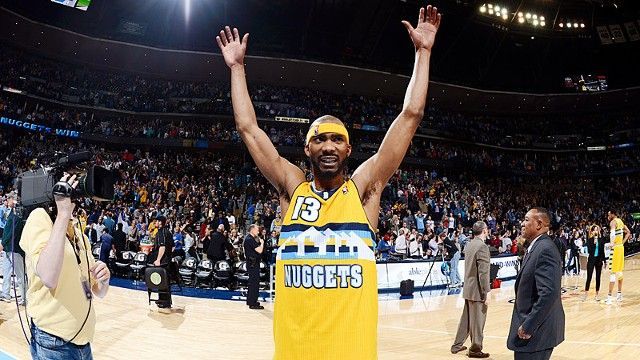Russell Westbrook is worth $344 million, and other lessons from the 2016 NBA salary cap...
Adam Rifkin stashed this in Nate Silver
Stashed in: LINSANITY, Basketball, LeBron James, Splash Brothers!
Sometimes the business of the NBA makes no sense to me.
Durant is harder to pin down than the average free agent. If he re-signs with the Oklahoma City Thunder, he could sign a five-year contract worth $153 million; if he signs with a different team, the most he could sign for is four years and $114 million — about $2 million less annually.2 But because of the way pay structure works in the NBA, Durant will have accrued enough “experience” in the league to jump up a tier in maximum pay after next season. That means both of those long-term figures could increase dramatically if Durant signs a two-year deal with an opt-out after the first year and then signs long-term next season.
This is a test of Durant’s risk tolerance for his personal finances, but for teams looking to sign Durant, it’s immaterial — Durant is a bargain at any price. Like other top players, his value on the court far exceeds the max salary. Last season, he played at a rate equal to a $54 million annual salary on the open market; over the next five seasons, CARMELO projects that he will be worth $268 million in production.
Over the same five-year period, CARMELO projects that Steph Curry will produce about $404 million in value, Russell Westbrook will produce about $344 million, and LeBron James will produce about $309 million. Karl-Anthony Towns, who has at least three years left on his rookie deal, projects at $290 million. (It’s important to remember that these projections essentially reflect an environment without a max salary but with a salary cap; in an uncapped scenario, they could very well be higher.) Under the current collective bargaining agreement, the best players in the league can’t come close to reaching those salaries.
This is the top-heavy nature of production in the NBA, and why superstars are so valuable just as a basic bookkeeping cheat code: They create surplus value for their teams (and more generally the league as a whole) that is funneled into less productive players. On the surface, this seems unfair to players like Durant or Curry, and it’s been a major sticking point for James in the past. But remember, the National Basketball Players Association negotiates the bargaining agreement that imposes a max salary, and while the union didn’t fare well in the last round of negotiations, the purpose of any union is the betterment of its constituent body as a whole — not just its most famous members. In a very real sense, Kevin Durant is paying for Timofey Mozgov’s contract, and that’s not necessarily a bad thing.
That’s one reason it makes sense for teams to splurge on players like Tristan Thompson. Before last season, CARMELO projected Thompson to be “worth” $36.1 million over the next five seasons. Thompson eventually signed a five-year, $82 million contract and produced a breakout season, moving his projection quite a bit. It now values him at about $56 million over the contract’s remaining four seasons, after having produced at a rate commensurate with a $17 million salary last season, for a total of $73 million as an updated total projection. But even if Thompson had played at a level below his excellent 2015-16, the difference between his value and his salary was covered by the surplus created by having LeBron producing $64 million of value while collecting $23 million in salary.
Another reason for “overspending” is the indisputible fact that the NBA market isn’t perfectly efficient. For instance, it’s been a running joke in some circles that the 76ers are threatening to extend a max contract that would exceed $90 million to Harrison Barnes, who found himself nailed to the bench in the most crucial moments of the NBA Finals and whom CARMELO projects to be worth about $62 million over that time period. But the 76ers are working their way out of a massive hole dug by former GM Sam Hinkie, whose Process saw the team become so poisonous to prospective players that agents of top draft candidates refused to grant the Sixers pre-draft workouts. The 76ers aren’t threats to make the Finals any time soon, and so headhunting surplus value is less important to them than signing viable NBA players as a show of basic institutional competence. Once Philadelphia becomes a functioning NBA club, it can concern itself more with maintaining value and making savvy signings, but one has to come before the other.
This isn’t to say that all overspending is warranted — many, many bad decisions will be made this offseason and next. For instance, CARMELO projects Joakim Noah to be “worth” $51 million over the next four seasons — not too far from the $72 million the Knicks are expected to offer him — but a big portion of that value is based on a return to form this coming season, in which he projects to play as a $20 million player, which I’m not sure I buy.
But at the very least, players understand the dynamics at work. There’s a reason James was so forceful pushing for a large contract for Thompson (who shares his agent) last offseason. For a long time, the status quo placed the financial burden of winning on the players. Stars, the thinking went, had to take less money to build a winning team. Just ask Dwyane Wade how that can go wrong. The new model saw Cavs owner Dan Gilbert shell out $107 million in salary (highest in the NBA) and more than $50 million in luxury tax (second-most in NBA history) to assemble the necessary championship-run pieces around James, who is collecting every penny of the max and is worth a good deal more than that.











11:34 AM Jul 02 2016